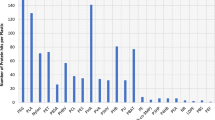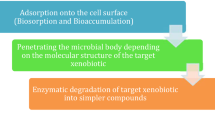Abstract
The effect of enrichment with phthalate on the biodegradation of polycyclic aromatic hydrocarbons (PAH) was tested with bioreactor-treated and untreated contaminated soil from a former manufactured gas plant (MGP) site. Soil samples that had been treated in a bioreactor and enriched with phthalate mineralized 14C-labeled phenanthrene and pyrene to a greater extent than unenriched samples over a 22.5-h incubation, but did not stimulate benzo[a]pyrene mineralization. In contrast to the positive effects on 14C-labeled phenanthrene and pyrene, no significant differences were found in the extent of biodegradation of native PAH when untreated contaminated soil was incubated with and without phthalate amendment. Denaturing-gradient gel electrophoresis (DGGE) profiles of bacterial 16S rRNA genes from unenriched and phthalate-enriched soil samples were substantially different, and clonal sequences matched to prominent DGGE bands revealed that β-Proteobacteria related to Ralstonia were most highly enriched by phthalate addition. Quantitative real-time PCR analyses confirmed that, of previously determined PAH-degraders in the bioreactor, only Ralstonia-type organisms increased in response to enrichment, accounting for 89% of the additional bacterial 16S rRNA genes resulting from phthalate enrichment. These findings indicate that phthalate amendment of this particular PAH-contaminated soil did not significantly enrich for organisms associated with high molecular weight PAH degradation or have any significant effect on overall degradation of native PAH in the soil.




Similar content being viewed by others
References
Altschul SF, Gish W, Miller W, Myers EW, Lipman DJ (1990) Basic local alignment search tool. J Mol Biol 215:403–410
Atagana HI (2006) Biodegradation of polycyclic aromatic hydrocarbons in contaminated soil by biostimulation and bioaugmentation in the presence of copper(II) ions. World J Microbiol Biotechnol 22:1145–1153
Barnsley EA (1983) Phthalate pathway of phenanthrene metabolism: formation of 2′-carboxybenzalpyruvate. J Bacteriol 154:113–117
Batie C, LaHaie E, Ballou D (1987) Purification and characterization of phthalate oxygenase and phthalate oxygenase reductase from Pseudomonas cepacia. J Biol Chem 262:1510–1518
Bogan BW, Lahner LM, Trbovic V, Szajkovics AM, Paterek JR (2001) Effects of alkylphosphates and nitrous oxide on microbial degradation of polycyclic aromatic hydrocarbons. Appl Environ Microbiol 67:2139–2144
Chang HK, Zylstra GJ (1998) Novel organization of the genes for phthalate degradation from Burkholderia cepacia DBO1. J Bacteriol 180:6529–6537
Chang HK, Zylstra GJ (1999a) Role of quinolinate phosphoribosyl transferase in degradation of phthalate by Burkholderia cepacia DBO1. J Bacteriol 181:3069–3075
Chang HK, Zylstra GJ (1999b) Characterization of the phthalate permease OphD from Burkholderia cepacia ATCC 17616. J Bacteriol 181:6197–6199
Chen S-W, Aitken MD (1999) Salicylate stimulates the degradation of high-molecular weight polycyclic aromatic hydrocarbons by Pseudomonas saccharophila P15. Environ Sci Technol 33:435–439
Cheung P-Y, Kinkle BK (2001) Mycobacterium diversity and pyrene mineralization in petroleum-contaminated soils. Appl Environ Microbiol 67:2222–2229
Cho BH, Chino H, Tsuji H, Kunito T, Nagaoka K, Otsuka S, Yamashita K, Matsumoto S, Oyaizu H (1997) Laboratory-scale bioremediation of oil-contaminated soil of Kuwait with soil amendment materials. Chemosphere 35:1599–1611
Choi KY, Kim D, Sul WJ, Chae JC, Zylstra GJ, Kim YM, Kim E (2005) Molecular and biochemical analysis of phthalate and terephthalate degradation by Rhodococcus sp. strain DK17. FEMS Microbiol Lett 252:207–213
Choi KY, Kim D, Chae JC, Zylstra GJ, Kim E (2007) Requirement of duplicated operons for maximal metabolism of phthalate by Rhodococcus sp. strain DK17. Biochem Biophys Res Commun 357:766–771
Colbert S, Schroth M, Weinhold A, Hendson M (1993) Enhancement of population densities of Pseudomonas putida PpG7 in agricultural ecosystems by selective feeding with the carbon source salicylate. Appl Environ Microbiol 59:2064–2070
Dandie CE, Thomas SM, Bentham RH, McClure NC (2004) Physiological characterization of Mycobacterium sp. strain 1B isolated from a bacterial culture able to degrade high molecular weight polycyclic aromatic hydrocarbons. J Appl Microbiol 97:246–255
Eaton RW (2001) Plasmid-encoded phthalate catabolic pathway in Arthrobacter keyseri 12B. J Bacteriol 183:3689–3703
Fuenmayor SL, Wild M, Boyes AL, Williams PA (1998) A gene cluster encoding steps in conversion of naphthalene to gentisate in Pseudomonas sp. strain U2. J Bacteriol 180:2522–2530
Grifoll M, Selifonov SA, Chapman PJ (1994) Evidence for a novel pathway in the degradation of fluorene by Pseudomonas sp. strain F274. Appl Environ Microbiol 60:2438–2449
Guerin TF (1999) Bioremediation of phenols and polycyclic aromatic hydrocarbons in creosote contaminated soil using ex-situ landtreatment. J Hazard Mater 65:305–315
Habe H, Miyakoshi M, Chung J, Kasuga K, Yoshida T , Nojiri H, Omori T (2003) Phthalate catabolic gene cluster is linked to the angular dioxygenase gene in Terrabacter sp. strain DBF63. Appl Microbiol Biotechnol 61:44–54
Hwang S, Cutright TJ (2002) Biodegradability of aged pyrene and phenanthrene in a natural soil. Chemosphere 47:891–899
Juhasz AL, Britz ML, Stanley GA (1997) Degradation of fluoranthene, pyrene, benz[a]anthracene and dibenz[a,h]anthracene by Burkholderia cepacia. J Appl Microbiol 83:189–198
Kamath R, Schnoor JL, Alvarez PJ (2004) Effect of root-derived substrates on the expression of nah-lux genes in Pseudomonas fluorescens HK44: implications for PAH biodegradation in the rhizosphere. Environ Sci Technol 38:1740–1745
Kanaly RA, Harayama S ( 2000) Biodegradation of high molecular weight polycyclic aromatic hydrocarbons by bacteria. J Bacteriol 182:2059–67
Kang H, Hwang SY, Kim YM, Kim E, Kim Y-S, Kim S-K, Kim SW, Cerniglia CE, Shuttleworth KL, Zylstra GJ (2003) Degradation of phenanthrene and naphthalene by a Burkholderia species strain. Can J Microbiol 49:139–144
Keum YS, Seo JS, Hu Y, Li QX (2006) Degradation pathways of phenanthrene by Sinorhizobium sp. C4. Appl Microbiol Biotechnol 71:935–941
Kim SJ, Kweon O, Jones RC, Freeman JP, Edmondson RD, Cerniglia CE (2007) Complete and integrated pyrene degradation pathway in Mycobacterium vanbaalenii PYR-1 based on systems biology. J Bacteriol 189:464–472
Kweon O, Kim SJ, Jones RC, Freeman JP, Adjei MD, Edmondson RD, Cerniglia CE (2007) A polyomic approach to elucidate the fluoranthene degradative pathway in Mycobacterium vanbaalenii PYR-1. J Bacteriol 189: 4635–4647
Lee SE, Seo JS, Keum YS, Lee KJ, Li QX (2007) Fluoranthene metabolism and associated proteins in Mycobacterium sp. JS14. Proteomics 7:2059–2069
Leys NM, Ryngaert A, Bastiaens L, Wattiau P, Top EM, Verstraete W, Springael D (2005) Occurrence and community composition of fast-growing Mycobacterium in soils contaminated with polycyclic aromatic hydrocarbons. FEMS Microbiol Ecol 51:375–388
Marchesi JR, Sato T, Weightman AJ, Martin TA, Fry JC, Hiom SJ, Dymock D, Wade WG (1998) Design and evaluation of useful bacterium-specific PCR primers that amplify genes coding for bacterial 16S rRNA. Appl Environ Microbiol 64:795–799
Muyzer G, de Waal EC, Uitterlinden AG (1993) Profiling of complex microbial populations by denaturing gradient gel electrophoresis analysis of polymerase chain reaction-amplified genes coding for 16S rRNA. Appl Environ Microbiol 59:695–700
Namkoong W, Hwang EY, Park JS, Choi JY (2002) Bioremediation of diesel-contaminated soil with composting. Environ Pollut 119:23–31
Negri M, Manfredini A, Saponaro S, Sorlini C, Bonomo L, Valle A, Zanardini E (2004) Solid phase treatment of an aged soil contaminated by polycyclic aromatic hydrocarbons. J Environ Sci Health A Tox Hazard Subst Environ Eng 39:1–17
Ogunseitan OA, Olson BH (1993) Effect of 2-hydroxybenzoate on the rate of naphthalene mineralization in soil. Appl Microbiol Biotechnol 38:799–807
Ogunseitan OA, Delgado IL, Tsai YL, Olson BH (1991) Effect of 2-hydroxybenzoate on the maintenance of naphthalene-degrading pseudomonads in seeded and unseeded soil. Appl Environ Microbiol 57:2873–2879
Powell SN (2006) Stable isotope probing of salicylate-degrading bacteria in polycyclic aromatic hydrocarbon-contaminated soil. Dissertation. University of North Carolina
Rehmann K, Noll HP, Steinberg CE, Kettrup AA (1998) Pyrene degradation by Mycobacterium sp. strain KR2. Chemosphere 36:2977–2992
Sabate J, Vinas M, Solanas AM (2006) Bioavailability assessment and environmental fate of polycyclic aromatic hydrocarbons in biostimulated creosote-contaminated soil. Chemosphere 63:1648–1659
Scelza R, Antonietta Rao M, Gianfreda L (2007) Effects of compost and of bacterial cells on the decontamination and the chemical and biological properties of an agricultural soil artificially contaminated with phenanthrene. Soil Biol Biochem 39:1303–1317
Seo JS, Keum YS, Hu Y, Lee SE, Li QX (2006) Phenanthrene degradation in Arthrobacter sp. P1-1: initial 1,2-, 3,4- and 9,10-dioxygenation, and meta- and ortho-cleavages of naphthalene-1,2-diol after its formation from naphthalene-1,2-dicarboxylic acid and hydroxyl naphthoic acids. Chemosphere 65:2388–2394
Singleton DR, Powell SN, Sangaiah R, Gold A, Ball LM, Aitken MD (2005) Stable-isotope probing of bacteria capable of degrading salicylate, naphthalene, or phenanthrene in a bioreactor treating contaminated soil. Appl Environ Microbiol 71:1202–1209
Singleton DR, Hunt M, Powell SN, Frontera-Suau R, Aitken MD (2007) Stable-isotope probing with multiple growth substrates to determine substrate specificity of uncultivated bacteria. J Microbiolog Meth 69: 180–187
Singleton DR, Sangaiah R, Gold A, Ball LM, Aitken MD (2006) Identification and quantification of uncultivated Proteobacteria associated with pyrene degradation in a bioreactor treating PAH-contaminated soil. Environ Microbiol 10:1736–1745
Smits THM, Devenoges C, Szynalski K, Maillard J, Holliger C (2004) Development of a real-time PCR method for quantification of the three genera Dehalobacter, Dehalococcoides, and Desulfitobacterium in microbial communities. J Microbiolog Meth 57:359–378
Stingley RL, Brezna B, Khan AA, Cerniglia CE (2004a) Novel organization of genes in a phthalate degradation operon of Mycobacterium vanbaalenii PYR-1. Microbiology 150: 3749–3761
Stingley RL, Khan AA, Cerniglia CE (2004b) Molecular characterization of a phenanthrene degradation pathway in Mycobacterium vanbaalenii PYR-1. Biochem Biophys Res Commun 322:133–146
Thompson JD, Higgins DG, Gibson TJ (1994) CLUSTAL W: improving the sensitivity of progressive multiple sequence alignment through sequence weighting, position-specific gap penalties and weight matrix choice. Nucleic Acids Res 22:4673–4680
Tian L, Ma P, Zhong J-J (2003) Impact of the presence of salicylate or glucose on enzyme activity and phenanthrene degradation by Pseudomonas mendocina. Proc Biochem 38:1125–1132
Vamsee-Krishna C, Mohan Y, Phale P (2006) Biodegradation of phthalate isomers by Pseudomonas aeruginosa PP4, Pseudomonas sp. PPD and Acinetobacter lwoffii ISP4. Appl Microbiol Biotechnol 72:1263–1269
van Herwijnen R, Springael D, Slot P, Govers HA, Parsons JR (2003a) Degradation of anthracene by Mycobacterium sp. strain LB501T proceeds via a novel pathway, through o-phthalic acid. Appl Environ Microbiol 69:186–190
van Herwijnen R, Wattiau P, Bastiaens L, Daal L, Jonker L, Springael D, Govers HA, Parsons JR (2003b) Elucidation of the metabolic pathway of fluorene and cometabolic pathways of phenanthrene, fluoranthene, anthracene and dibenzothiophene by Sphingomonas sp. LB126. Res Microbiol 154:199–206
van Herwijnen R, Joffe B, Ryngaert A, Hausner M, Springael D, Govers HA, Wuertz S, Parsons JR (2006) Effect of bioaugmentation and supplementary carbon sources on degradation of polycyclic aromatic hydrocarbons by a soil-derived culture. FEMS Microbiol Ecol 55:122–135
Vila J, Lopez Z, Sabate J, Minguillon C, Solanas AM, Grifoll M (2001) Identification of a novel metabolite in the degradation of pyrene by Mycobacterium sp. strain AP1: actions of the isolate on two- and three-ring polycyclic aromatic hydrocarbons. Appl Environ Microbiol 67:5497–5505
Widada J, Nojiri H, Kasuga K, Yoshida T, Habe H, Omori T (2002) Molecular detection and diversity of polycyclic aromatic hydrocarbon-degrading bacteria isolated from geographically diverse sites. Appl Microbiol Biotechnol 58:202–209
Williams CM, Grimes JL, Mikkelsen RL (1999) The use of poultry litter as co-substrate and source of inorganic nutrients and microorganisms for the ex situ biodegradation of petroleum compounds. Poult Sci 78:956–964
Yu Z, Morrison M (2004) Comparisons of different hypervariable regions of rrs genes for use in fingerprinting of microbial communities by PCR-denaturing gradient gel electrophoresis. Appl Environ Microbiol 70:4800–4806
Zhou NY, Fuenmayor SL, Williams PA (2001) nag genes of Ralstonia (formerly Pseudomonas) sp. strain U2 encoding enzymes for gentisate catabolism. J Bacteriol 183:700–708
Acknowledgments
We thank Chad Roper for assistance in the quantification of PAH by HPLC. We also thank Wei Sun of the UNC Department of Biostatistics for helpful discussions concerning data analyses. This work was supported by the National Institute of Environmental Health Sciences (grant number 5 P42 ES05948).
Author information
Authors and Affiliations
Corresponding author
Rights and permissions
About this article
Cite this article
Singleton, D.R., Richardson, S.D. & Aitken, M.D. Effects of enrichment with phthalate on polycyclic aromatic hydrocarbon biodegradation in contaminated soil. Biodegradation 19, 577–587 (2008). https://doi.org/10.1007/s10532-007-9163-1
Received:
Accepted:
Published:
Issue Date:
DOI: https://doi.org/10.1007/s10532-007-9163-1




